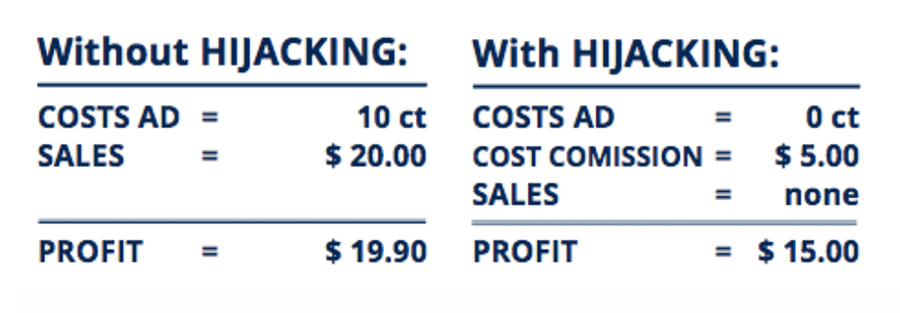AD HIJACKING
This Is How Affiliate Partners Betray You Without You Even Noticing It
There is a dark number of affiliates abusing their partnership. They misguide customers who are initially searching for your brand by using your brand keyword or even an exact copy of your ad. This special type of brand bidding is called ad hijacking. Today, the tricks of affiliates are so well-developed that you as brand owner or even affiliate manager have almost no chance to notice the fraud.
How Does Ad Hijacking Work?
The affiliate partner places an exact copy of your ad and surpasses your bidding price with just a few cents. The consequence is that the original ad disappears in the search results of Google, as Google displays only one ad with a certain Display Url. The affiliate outbids you. All customers searching for your brand keyword will now click on the hijacked ad and get guided through the channels of your affiliate partner. Your own ad impressions vanish.
The result is that you end up paying an unjustified commission for customers that originally could have been yours. Your margin decreases significantly. You loose money without even knowing.
Why is it Nearly Impossible to Notice the Fraud – Even for Affiliate Managers?
When we started AdPolice in 2008, affiliate fraudsters were still quite inexperienced and usually left at least a few traces that were noticeable for brand owners or affiliate managers.

Yet today, affiliates are a lot more sophisticated and highly specialized – so are their frauds. Basically, there are just two minor symptoms from which you might notice an affiliate fraud.
1. Have Your Ad Impressions Decreased for No Reason?
If a copied ad replaces your original ad, your impressions will fall or even disappear. Thus, an uncommon decrease of impressions in Google Analytics may be one hint for a fraud. Unfortunately, affiliates have learned that it is smarter not to make a huge impact and steal all impressions but to pick off just a lot of tiny percentages here and there. This way, they can stay under the radar. Yet, in large, they still make a huge profit.
2. Have There Been Any Unusual High Sales of Certain Affiliates?
Significant increases in the conversion rates of your affiliates can also be indications of an affiliate fraud, especially if the curve has unusual peaks for example at nights or at weekends. Affiliates often use times when nobody is in the office. But again, affiliates have gained experience over the years and just steal a small percentage of their sales via affiliate fraud. The majority of revenue is usually generated legally. This makes them less likely to get caught.
The Most Successful Techniques How Affiliate Fraudsters Hide in Disguise
There are many different means that help affiliates fraudsters to remain concealed. The worst part is that in most cases they combine several techniques at once. This makes it almost impossible for a non-specialist to detect the fraud.
Geo-Targeting
Affiliates place their illegitimate ads everywhere except the brand owner’s and the online marketing agency’s location. This makes the fraud invisible for the brand owner or the affiliate manager.
Temporary Restriction
Illegitimate ads are only shown at nights or on weekends, when the brand owner and the online marketing agency are less likely to note the fraud.
Misspelling
Typos are a common mistake Internet users make and a welcome technique for affiliates to use your (misspelled) brand keyword in illegitimate ads without getting busted. Yet still, they are stealing your traffic and collect the commission from you.
Smaller Search Engines
Of course Google is the most important search engine worldwide. That’s why brands almost exclusively focus on Google. However, your affiliate partners don’t. Especially when it comes to affiliate fraud, small search engines such as Yahoo, Ask, Bing, and AOL or foreign search engines such as Baidu (China), Naver (South Korea), and Yandex (Russia) are very vulnerable. Usually, the brand owner and the online marketing agency monitor those minor search engines only infrequently, if at all. So there is enough room for affiliates to use the brand keyword quietly and collect the commission for the fraud.
Cloaking and Dynamic Redirects
Affiliates try to hide their identity through cloaking domains and dynamic redirects. Thus, the website and even the source code do not reveal the identity of the affiliate fraudster.
What Can You Do About it?
The bottom line is: It is nearly impossible even for you as affiliate manager to detect affiliate fraud. Only a highly specialized technology and monitoring can reveal such infringements.
At AdPolice, we have special tools and a longtime expertise to expose affiliate fraud and to hold them accountable. You can either choose to take action yourself with the help of our professional software tools or let us handle everything.
Monitoring
- Reliable detection also at night and on weekends
- Nationwide infrastructure for identifying regionally temporary restricted ad campaigns
- Permanent queries every minute
- Internal data base of affiliates with affiliate fraud records worldwide
- Queries also in small search engines (Ask, Aol, etc) or in big foreign search engines (Baidu – China, Naver – South Korea, Yandex – Russia, etc.)
- Queries of misspellings
Follow-Up
- Disclosure of transfer chain including partner id
- Liquidation of cloaking domain to identify the affiliate
- Reporting to affiliate network
- Ongoing surveillance of repeat frauds
- Success reporting








